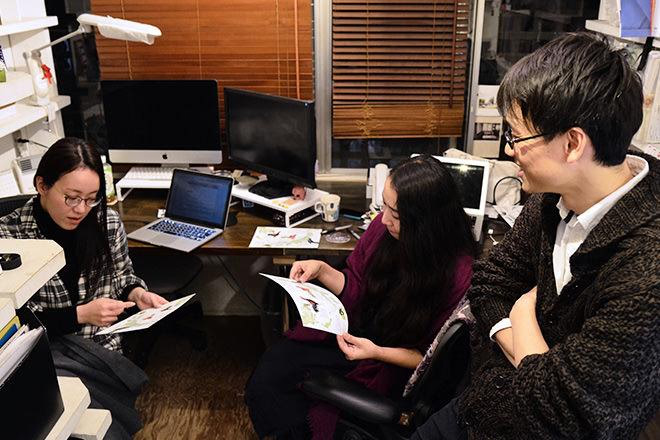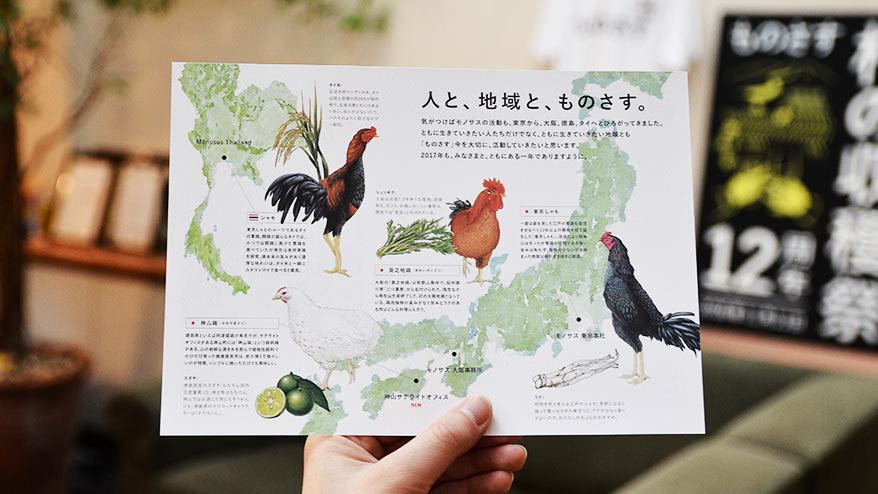Hello. This is Onogi from the design department.
At Monosus, we send out "Monosasu New Year's Cards" every year. In order to avoid being buried in the many New Year's cards that are likely to be sent to customers, we send them at the end of the previous year rather than the beginning of the new year, and in a slightly larger size, to thank customers for the past year and to greet them for the coming year.
Creating New Year's cards has become an annual tradition, and as the anniversary party in November comes to an end, I get excited, thinking, "Ah, it's that time of year again..." In previous years, I was free to design freely without worrying too much about the company, but now that a year has passed since the Monosus website was renewed, the company's tone and manner has become clear, so I thought that this year's New Year's cards would convey a little more of the "Monosus feel."
This year is the Year of the Rooster, so the design is themed on the theme of chicken. We wanted to make sure that people don't just receive the gift, but that they learn about Monosus and are a little "wow" about it, so we'd like to show you what's going on behind the scenes.
The theme is "food"
"Next year, Monosus will be doing food-related business, so it might be good to name it after that."
This advice comes from Manabe (head of the production department), who is the manager of the new business called “Food Hub Project※”, which has been running since last year with the theme of “locally produced food”. Last year, he also gave us advice on the direction of New Year’s cards in conjunction with the renewal of the Monosasu website.
*This project was started by a working group considering strategies for regional revitalization in Kamiyama Town. It is run by Food Hub Project Co., Ltd., a company jointly established by the Kamiyama Town Office, Kamiyama Tsunagu Public Corporation, and Monosus Co., Ltd. With the guiding principle of "Grow, Make, Eat, Connect," Kamaya and Kamapan & Store are scheduled to open in March 2017.
In addition, I line up the New Year's cards, free papers, magazines, etc. that I have received from various companies and think about what I would be happy to receive.
Food, chicken... Yakitori... something like that? It seems like a simple idea, and I wonder if it will work as a picture. But I can't think of anything else.
Manabe: "What if we lined up all the chickens from around the world? No, let's line up all the chicken dishes!"
"That's fine!" I thought to myself, but when I actually drew it, I thought it might be interesting because it's a unique design, so I decided to do the right thing as a designer and say, "I'll just give it a try!"
The conclusion is "base x local chicken = ??"
When starting the design, I researched chicken dishes from around the world. My first impression was that they were all brown. I tried to draw just one illustration, but when I thought about lining up various dishes, the size was limited and the colors seemed to be one-sided, so I decided that it would be a bad idea to go down this route.
Remembering that one idea was to simply display chicken instead of a meal, I ask myself, "Maybe that will weaken the concept of food."
When I'm troubled like this, I consult with Monosus member Iwaki, and some kind of clue to the solution comes out. Iwaki is a member of the production department, and although his job title is unclear, he is a multi-player who has several very important jobs such as business management and proofreading the Monosus website. He originally likes looking at art and design, and when I consult with him, he gives me various ideas and gives me advice.
Iwaki: "Now that I think about it, Mr. Hayashi's (our company president) wife prepared a cake decorated with decorations related to Monosus' headquarters for our anniversary party."
Monosus has completed construction of a new satellite office in Kamiyama, Tokushima Prefecture, bringing its total base to four. This is the first time that the company has added the concept of "region."
Speaking of regions and chickens, "local chicken" comes to mind. I had an idea: why not make local chickens from the area where Monosus is based the main focus of the design? If we also placed agricultural products related to the area, the relationship between the land and food would be emphasized.
However, just displaying local chicken and local specialties is a little boring. Isn't there a way to visually express the land and local chicken in a more understandable way? The result of thinking was the idea of an "illustrated guide." The local chicken is laid out against a map background, and its characteristics and introduction are written. By doing this, it becomes something extra that goes beyond just receiving it. That's what I thought.
From the big concept, we were able to see the concrete outcome of the design.
As I went along, I noticed some pitfalls that I'm glad I noticed.
First of all, since a new satellite office is being established, I will start by drawing "Kamiyama Chicken", a brand of chicken from Kamiyama. I will research the details of the chicken, such as "They can only be raised in mountainous areas with clean water" and "Only females are raised in free-range cages", and continue drawing, keeping in mind that I will write about it later.

Left) First I sketched out the outline, then I looked at the web and other materials and carefully painted in the details, capturing the character's unique features. The crest is pretty creepy...
Right) The map in the background was photographed and edited to look like watercolors using a smartphone app called "Waterlogue."
So, the local chicken in Osaka is "Aoi no Jidori". However, when I looked closely, I noticed that the website had not been updated at all. Even when I looked up "Aoi no Jidori" in other sources, there was very little information... I began to wonder, "Does this local chicken really exist?" So I called the company listed as the producer...
"Sorry, but we haven't produced it for several years now."
When I asked, I found out that they had originally imported chicks from Wakayama and were raising them, but that they were no longer being raised in Osaka. I was so confident that I was on the verge of spreading false information. The fact remains that it had been sold as a local Osaka chicken in the past, so there was no need to drastically reconsider the concept, but it was a good lesson to avoid blindly accepting information.
Monosus members take even the smallest things seriously
While adjusting the overall design, we add descriptions of the local chicken and local specialties. We write drafts of the text while researching various things, but it is very difficult to adjust the amount of text so that it does not get in the way of the New Year's card design.
I have very little confidence in my writing skills, so I decided to have Monosus member Uemura check my research to make sure there were no mistakes. Uemura, like Iwaki, is also a member of the production department and has excellent writing skills.
This is where Uemura's research skills shine. I thought I had done quite a bit of research, but she researched chickens even more, and instead of just explaining local chickens, she added bits of information on how to eat them deliciously, creating a piece that was closer to the concept of "food." I had worked with her on a project for a certain university in the past, and I remember her thoroughly researching the site structure and making a major contribution to the project.
By the time the book was almost complete, Uemura, Iwaki, and Onoki had become so knowledgeable about chickens that they were able to have a little discussion. Uemura said, "I still haven't written enough, I want to talk more about chickens." Uemura's love for chickens, who he loves to see and eat, is overflowing.

"Tokyo Shamo is a lot of work because you cross it with a Rhode Island Red and then cross it again with a purebred Shamo," "So it's a quarter?" This was a mysterious conversation.
Completed. "People, Regions, and Measures."

The illustrations and text are finished, and the whole book is designed to look like an illustrated book. On the back is an introduction to the Food Hub Project, which will be launched in earnest this year, and the shops.
The main copy is "People, Regions, and Measures."
The final touch to the New Year's card design is a message from our CEO, Hayashi. It feels like it was designed with these words in mind. (I won't tell you that the initial deadline was delayed by about a week because "Onogi-kun, I can't write it.")
This year, it was completed thanks to the combined advice and ideas of many members.
As the company has grown, the way we think about things and communicate has changed throughout the organization. New Year's cards are one example of this. Unlike a few years ago when Furuhat and I were designing them as we pleased, I think they have evolved to fit the company.
You don't have to look at it carefully, but I hope you'll take a little more time to look at it than you would with other New Year's cards. I look forward to seeing you again next year!

